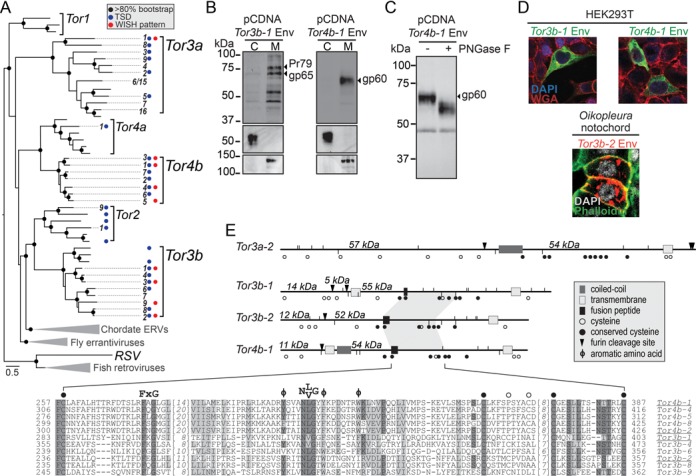Figure 1.

Classification and biochemical features of Tor envelope proteins. (A) Phylogeny of Tor elements based on Pol. Inside each group, numbered branches indicate elements whose embryonic expression was tested with WISH. The elements Tor3a-6 and -15 have very similar Pol but other genes are divergent. Red dots indicate elements showing tissue-specific WISH patterns in the embryo. Blue dots show when Target Site Duplications are present. Scale bar shows number of substitution per site. RSV, Rous Sarcoma Virus. (B) Subcellular fractionation of Tor3b-1 and 4b-1 Env. Cytoplasm (C) and membranes (M) fractions were purified from HEK293T cells expressing tagged Env and analysed by western blot. The top panel shows detection of glycosylated Env peptide (gp) and Env precursor before furin cleavage (Pr). The fusion tag used in these experiments adds an extra 5 kDa to the protein molecular weight (MW). Middle and bottom panels show detection of β-tubulin and Cadherin, respectively. (C) Deglycosylation assay of Tor4b-1 Env. Treatment of cell extracts with Peptide-N-Glycosidase F resulted in an Env bandshift. (D) Micrographs showing Tor3b-1 and 4b-1 Env localization in human and Oikopleura cells. Nuclei were stained with DAPI and cell boundaries were stained using Wheat Germ Agglutinin or Phalloidin. (E) Primary structure of Tor Env. At top, schematic representation of Env from selected Tor3a, 3b and 4b elements. The arrows show predictions of furin proteolytic cleavage and numbers in italic indicate the MW of the resulting fragments. Vertical lines show residues favourable for N-glycosylation (upwards) and glycosaminoglycan attachment (downwards). The shaded area shows the region with highest conservation found in Tor4/3b Env, corresponding to the multiple sequence alignment below. Positions highlighted in dark grey show amino acids identical in at least half of Tor3b and 4b sequences, positions highlighted in light grey show conservative substitutions. Full-length env cDNAs were obtained for elements whose names are underlined.
